Science & Environment
Sam Altman-backed nuclear startup Oklo to start site work for Idaho microreactor

An artist rendering of the Oklo powerhouse, called the Aurora. Image credit: Gensler
Image courtesy Oklo
Nuclear startup Oklo is moving closer to initial construction of its first commercial microreactor, CEO Jacob DeWitte told CNBC in an interview.
Oklo has received the greenlight from the Department of Energy to conduct site investigations for the planned reactor at Idaho National Laboratory in Idaho Falls, the company announced on Wednesday.
“This sets the stage for doing all the initial site … prep work, and what I would call initial construction activities,” DeWitte said. He expects Oklo to break ground at the Idaho site in 2026, with plans to have the reactor up and running by the following year.
Oklo, however, still needs approval from the Nuclear Regulatory Commission to build and operate the plant after its first application was rejected in 2022. The CEO acknowledged there’s a risk the 2027 start date gets pushed out depending on how long the NRC review takes.
Oklo, which aims to build, operate and directly sell power to customers under long-term contracts, went public in May through a merger with OpenAI CEO Sam Altman’s SPAC, AltC Acquisition Corp. Altman serves as Oklo’s chairman.
Electric demand is projected to surge. The tech sector has been feverishly building data centers to handle the power-intensive computations needed for artificial intelligence, while domestic manufacturing is expanding and the economy becomes increasingly electrified.
The company’s microreactors, called Aurora, promise smaller and simpler designs that will range in size from 15 megawatts to as much as 100 megawatts or more. The average nuclear reactor in the current U.S. fleet is around 1,000 megawatts, according to the Department of Energy.
‘Industry has radically fallen short’
Oko’s stock has gained nearly 26% since Constellation Energy unveiled plans Friday to restart Three Mile Island nuclear plant to help power Microsoft’s data centers. Its shares are down 54% since its NYSE debut.
DeWitte said the Three Mile Island restart is a “testament” to how much the tech sector sees “energy going up and how important it is to lock-in secure supplies of it.”
“What we’re seeing is hyperscalers taking the approach of trying to secure large capacity from existing plants to the greatest extent that they can, which makes sense, because some of that can be the nearest-term power delivery,” DeWitte said.
But the nuclear “industry has radically fallen short of its ability to keep up with the market interest,” DeWitte said. “The challenge has just been the industry’s offerings in terms of product, the business model and ability to execute, have just been horrible,” he said.
“All of that is elements around which disruption has needed to take place to sort of change the paradigm,” he said. “And that’s where we really taken a different angle.”
NRC review crucial
Oklo, however, has faced its own challenges. The NRC rejected Oklo’s first license application due to missing safety information. It plans to file its application again in 2025, DeWitte said. It is currently in a pre-application review process, he said.
DeWitte attributed the denial of Oklo’s first application to disruptions caused by the Covid-19 pandemic that prevented in-person audits. Oklo submitted its application on March 11, 2020, the day the World Health Organization declared a pandemic.
“Everything changed,” DeWitte said of the pandemic’s impact on the review process. “This missing information was largely missing through communication challenges,” he said.
The CEO acknowledged the NRC review could delay the 2027 start date for the Idaho microreactor: “There’s definitely risk. At the end of the day, we can’t control the NRC review timeline,” he said.
Oklo could get a tailwind from the recently enacted ADVANCE Act, which directs the NRC to speed up decisions on license applications to build and operate reactors.
Future business
DeWitte said Oklo’s business is not contingent upon when the Idaho plant goes online. The company has 1,350 megawatts of interest through letters of intent with potential customers, a 93% increase from 700 megawatts in July 2023, according to the company’s recent earnings presentation.
The CEO said Oklo aims to bring plants online “in multiples per year” starting in 2028 to 2029. “From there, it’s really a game about scaling up the supply chain accordingly,” he said.
Oklo’s microreactors are a good fit for data centers, which are built out in individual halls with energy needs of less than 50 megawatts, about the size of the company’s plants, he said.
“They kind of build them out in modules that are pretty similar to what we power, that’s very much on purpose, and so we can build up with them,” DeWitte said.
Nuclear fuel has been a big constraint on Oklo, DeWitte said. In May, the U.S. banned uranium imports from Russia, which made up about 35% of the U.S. nuclear fuel imports. The Biden administration is investing $2.7 billion to stand up domestic production.
Oklo has a partnership with Centrus Energy, a U.S.-based nuclear fuel supplier. Centrus began enrichment operations in Piketon, Ohio, last October, but the domestic supply chain isn’t producing at the scale needed today, DeWitte said. However, Oklo has secured the fuel it needs for the Idaho plant.
The company’s rectors will have the ability to recycle fuel, which will help to diversity its supply chain, DeWitte said. But recycled fuel likely won’t be available in meaningful quantities until 2029 or beyond, he said.
Oklo posted a net loss of $53 million for the six months ended June 30. The company has not generated any revenue yet. That will come when it generates power at its first plant.
“Once we turn on that revenue operation, you’re usually locked into a 20-year — and in some cases, potentially longer — power purchase agreements,” CEO said. “You’re going to be getting the revenues for the next 20 years and then growing from there.”
Science & Environment
Prince William says make peace with nature
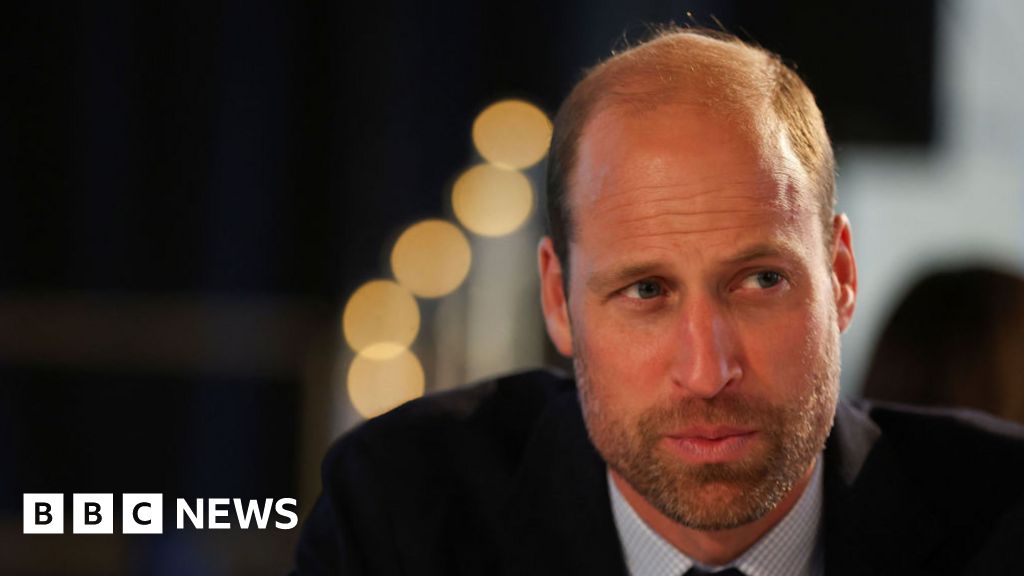
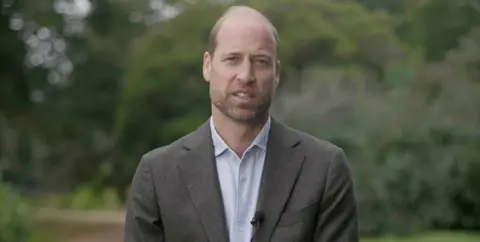 Kensington Palace
Kensington PalaceThe Prince of Wales has issued an urgent call to end environmental destruction and to “make peace with nature”.
“We are living at odds with the natural world – and it is buckling under the pressure of our actions,” he said, in a video message played at a Campaign for Nature event at the General Assembly of the United Nations, in New York.
Prince William said climate change and the prospect of a million species facing extinction represented the most pressing “existential threat”.
His speech followed the announcement of the finalists for the fourth year of the prince’s Earthshot awards for international ideas to improve sustainability.
 Earthshot
Earthshot“If we are to keep this planet liveable for our children and grandchildren, we must act urgently,” the prince said, in a speech that had echoes of the eco-campaigning of his father, King Charles III.
“We can and must change our relationship with the natural world.”
Such a reset in the relationship would mean economic changes, “realigning financial flows from destruction to regeneration”.
“It means change,” the prince said, calling on international leaders “to halt the unsustainable production and consumption of natural resources”.
“We must act to save our rivers, oceans, savannas, mangroves and forests, as well as the communities that protect and live alongside them,” he said.
 Earthshot
EarthshotThe 15 finalists for this year’s Earthshot awards were also announced in New York, recognising innovative ways of protecting the environment, drawn from 2,500 nominations, including:
- a project to reduce waste and cut air pollution in Ghana
- building a social enterprise around farming seaweed in the Philippines
- solar-powered refrigeration in Kenya
- earthquake-resilient bricks in Nepal
- a scheme in Kazakhstan to protect a type of antelope on the brink of extinction
- a project in Scotlant to feed fish using a by-product from distilling whisky
The five winners, to be revealed at an event in Cape Town, South Africa, in November, will receive £1m each.
Meanwhile, the Princess of Wales is continuing her return to work, after the end of her chemotherapy.
On Tuesday, she held a meeting in Windsor Castle, to plan her annual Christmas carol concert in Westminster Abbey.
Science & Environment
10 things to watch in the stock market Wednesday, including automaker downgrades
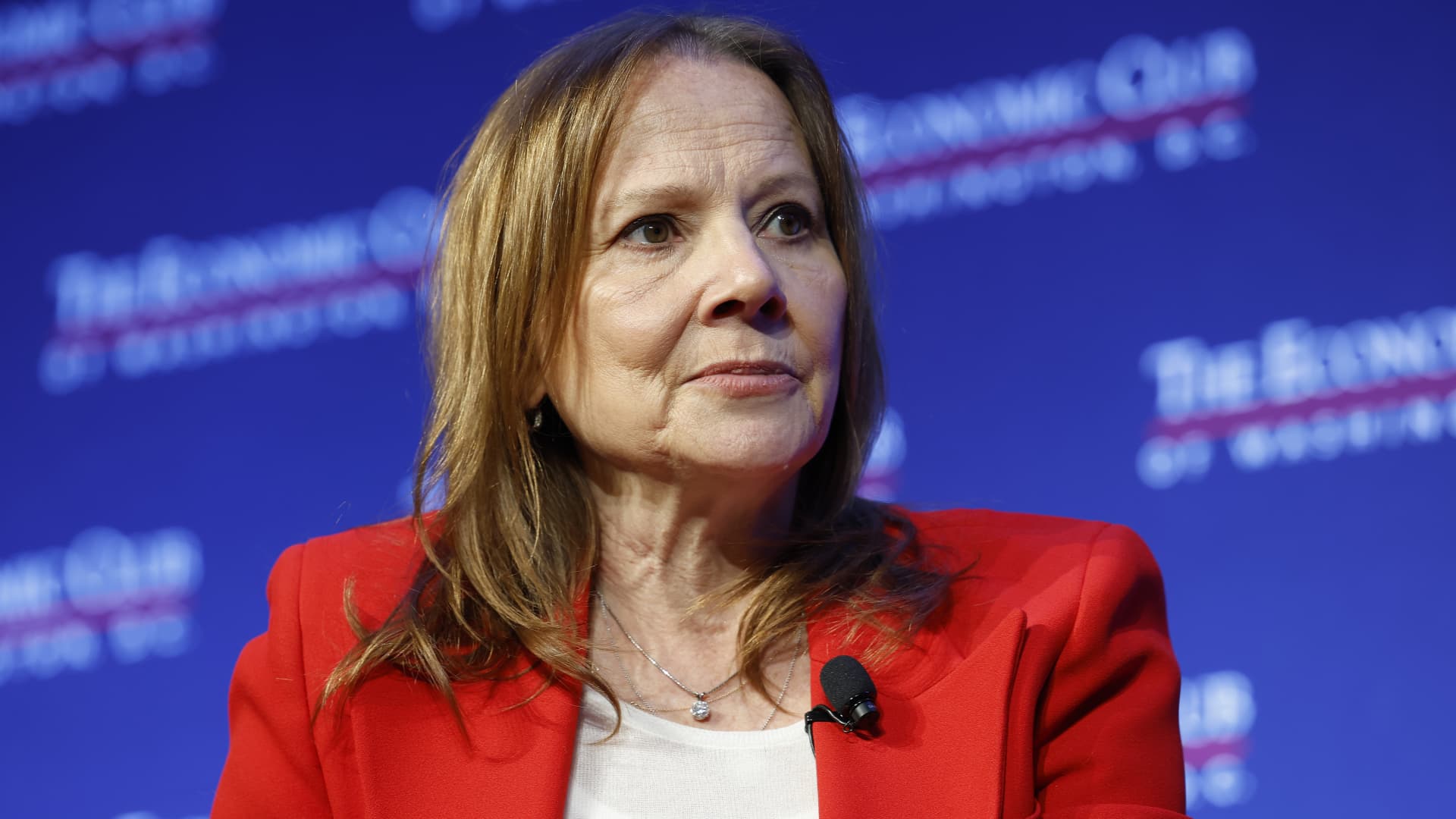
Top 10 things to watch Wednesday, Sept. 25
— Today’s newsletter was written by the Investing Club’s director of portfolio analysis, Jeff Marks.
1. The S&P 500 is on track for a muted open Wednesday following another record close Tuesday. Club holding Nvidia helped lift the market Tuesday but earnings loom from fellow chipmaker Micron. Our trusted momentum indicator, the S&P Short Range Oscillator, remains very overbought.
2. Morgan Stanley’s well-known auto analyst Adam Jonas downgraded his view on the U.S. auto industry to “in line” from attractive while also lowering his ratings on Ford, General Motors and Rivian. Jonas cited a range of factors for his sector downgrade, including Chinese competitors and vehicle affordability in the U.S. We sold out of Ford earlier this year.
3. Tyson Food was downgraded to a sell-equivalent underweight at Piper Sander on worsening beef margins and rising chicken supply. Shares, down more than 4% over the past month, were lower Wednesday.
4. KeyBanc upgraded DoorDash to an overweight buy and lifted its price target on the food delivery platform to $177 a share. Analysts said they’ve become more confident in DoorDash’s ability to sustain gross order volume growth and demonstrate operating leverage. The firm also raised its price target on Uber to $90 on a belief that cost discipline can further boost earnings.
5. Wells Fargo upgraded oilfield services provider Baker Hughes to overweight from a hold-equivalent, citing its diversified business model. It lowered its price targets on peers Halliburton and SLB to reflect a more muted macro outlook. Despite a lift Tuesday on China stimulus news, oil prices have been trending lower since the spring.
6. Baird analysts added Foot Locker to their “Bearish Fresh Pick Trading Call” list through November, which means they are negative on the stock over that stretch. They cited what they see as signs of softer spending trends and lower near-term sales visibility. CNBC’s Gabrielle Fonrouge had a nice look at Foot Locker’s turnaround efforts earlier this week.
7. Hewlett Packard Enterprise was upgraded to a buy-equivalent overweight at Barclays on growing AI server revenues, improvement in storage, and accretion from the Juniper Networks deal. The server makers like HPE, Super Micro Computer and Dell Technologies have been a closely followed group this year.
8. Evercore ISI downgraded Union Pacific to a hold-equivalent in line rating from outperform. Analysts think the railroad stock looks fully valued at around $249 a share based on its medium-term earnings outlook.
9. Expedia was downgraded to hold at Cowen on a slower turnaround in its business-to-consumer operations, which include vacation rental platform Vrbo and Hotels.com. Those brands have been losing share, according to analysts.
10. Oppenheimer cut its price target on Club holding Alphabet to $185 a share due to uncertainty on the Department of Justice’s antitrust pursuits. The company lost a case last month over its Google Search business and is in currently in court to defend its advertising business against monopoly allegations.
Sign up for Jim’s Top 10 Morning Thoughts on the Market email newsletter for free
(See here for a full list of the stocks at Jim Cramer’s Charitable Trust.)
As a subscriber to the CNBC Investing Club with Jim Cramer, you will receive a trade alert before Jim makes a trade. Jim waits 45 minutes after sending a trade alert before buying or selling a stock in his charitable trust’s portfolio. If Jim has talked about a stock on CNBC TV, he waits 72 hours after issuing the trade alert before executing the trade.
THE ABOVE INVESTING CLUB INFORMATION IS SUBJECT TO OUR TERMS AND CONDITIONS AND PRIVACY POLICY, TOGETHER WITH OUR DISCLAIMER. NO FIDUCIARY OBLIGATION OR DUTY EXISTS, OR IS CREATED, BY VIRTUE OF YOUR RECEIPT OF ANY INFORMATION PROVIDED IN CONNECTION WITH THE INVESTING CLUB. NO SPECIFIC OUTCOME OR PROFIT IS GUARANTEED.
Science & Environment
Europe’s deadly floods offer glimpse of future climate

 afp
afpCentral Europe’s devastating floods were made much worse by climate change and offer a stark glimpse of the future for the world’s fastest-warming continent, scientists say.
Storm Boris has ravaged countries including Poland, the Czech Republic, Romania, Austria and Italy, leading to at least 24 deaths and billions of pounds of damage.
The World Weather Attribution (WWA) group said one recent four-day period was the rainiest ever recorded in central Europe – an intensity made twice as likely by climate change.
On a positive note, the storm was well forecast, meaning some regions were better prepared for it, likely avoiding more deaths.
Scientists at WWA work out how much of a role climate change played in an extreme weather event by comparing it with a model of how bad that storm, drought or heatwave might have been in a world where humans hadn’t been burning fossil fuels for nearly 200 years.
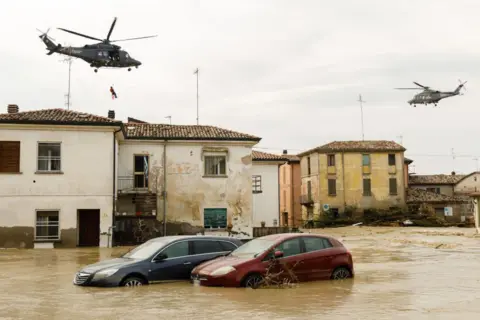 GEtty
GEttyThe kind of rainfall unleashed by Boris is thankfully still rare – expected to occur about once every 100-300 years in today’s climate, which has warmed by about 1.3C due to greenhouse gas emissions.
But if warming reaches 2C, similar episodes will become an extra 5% more intense and 50% more frequent, the WWA warned.
Without more ambitious climate action, global warming is expected to reach around 3C by the end of the century.
“This is definitely what we will see much more of in the future,” said Friederike Otto, senior lecturer in climate science at Imperial College London and co-author of the WWA study.
“[It] is the absolute fingerprint signature of climate change […] that records are broken by such a large margin.”
The record rains fit into the broader pattern of how Europe’s climate is changing in a warming world.
Europe is the fastest-warming continent. The last five years were on average around 2.3C warmer than the second half of the 19th Century, according to the Copernicus climate service.
This not only brings much more frequent and intense heatwaves, but also more extreme rainfall, particularly over north and central Europe. The picture is more complicated in southern Europe, due to shifts in large-scale weather patterns.
The simplest reason for more intense rainfall in a hotter world is that a warmer atmosphere can hold more moisture – about 7% for every 1C. This extra moisture can lead to heavier rainfall.
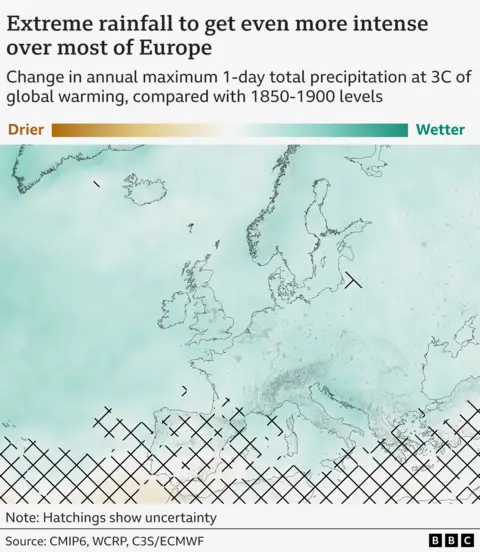
‘Stalling’ weather systems
One reason Boris has produced so much rain is that the weather system got ‘stuck’, dumping huge amounts of water over the same areas for days.
There is some evidence that the effects of climate change on the jet stream – a band of fast-flowing winds high up in the atmosphere – may make this ‘stalling’ phenomenon more common. But this is still up for debate.
Even if we don’t get more ‘stalled’ weather systems in the future, climate change means that any that do get stuck can carry more moisture and therefore be potentially disastrous.
“These weather patterns occurred in a warmer climate because of our greenhouse gas emissions, [so] the intensity and volume of rainfall was larger than it would have otherwise been,” explains Richard Allan, professor in climate science at the University of Reading.
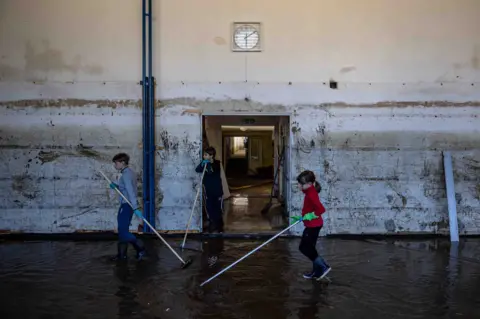 Epa
EpaWeather forecasts are continually improving, and in this case the huge levels of rainfall that triggered the floods were forecast several days in advance.
That meant flood preparations could be put in place.
That’s partly why the death toll was not as bad as previous major flooding in 1997 and 2002, even though the recent rain was heavier in many places and the floods covered a larger area.
“There has been a lot of money spent after the previous two floods to [install and update] the flood defences,” explains Mirek Trnka of the Global Change Research Institute in the Czech Republic, one of the countries most affected by the flooding.
In the city of Brno, for example, where Prof Trnka is based, not all of the flood defences had been completed, but the advanced warning allowed authorities to strengthen areas where there was still work to be done.
Not everywhere in Europe has been as fortunate. The EU has pledged €10bn (£8.3bn) in emergency repairs to help affected areas.
“It shows just how expensive climate change is,” says Dr Otto.
Over recent decades, improved flood protection has largely shielded communities from increased impacts.
But there are concerns that rising temperatures – and so ever increasing extreme rainfall – could make them ineffective.
“The [severity of the] flood events is going to increase considerably in the future, so if you keep the flood protections at the same level as they are today, the impacts may become unbearable for societies in Europe,” explains Francesco Dottori of IUSS in Pavia, Italy.
There is of course a clear way to stop these rainfall events from getting ever worse – cutting emissions of planet-warming gases such as carbon dioxide.
“Our simulations show that if you are able to keep future global warming below 1.5C, which is one of the targets of the Paris agreement, then future flood damage will be cut by half compared to the [business as usual] scenario,” Dr Dottori adds.
Otherwise, we know what will happen to these events in the future, Prof Allan says.
“The intensity of rainfall and these weather events will only get worse.”
Map by Muskeen Liddar.
Science & Environment
Bankman-Fried accomplice Caroline Ellison sentenced in FTX fraud

Caroline Ellison, former chief executive officer of Alameda Research LLC, right, arrives at court in New York, US, on Tuesday, Sept. 24, 2024.
Michael Nagle | Bloomberg | Getty Images
Caroline Ellison, the star witness in the prosecution of her former boyfriend, FTX founder Sam Bankman-Fried, was sentenced Tuesday in New York federal court to two years in prison and ordered to forfeit $11 billion for her role in the massive fraud and conspiracy that doomed the cryptocurrency exchange once valued at $32 billion.
The prison term was significantly stiffer than the recommendation by the federal Probation Department that Judge Lewis Kaplan sentence Ellison to three years of supervised release, with no time at all behind bars. Ellison’s lawyers also had asked for a no-prison sentence.
Ellison, who had run Alameda Research, a hedge fund connected to FTX, agreed to a plea deal in December 2022, a month after FTX spiraled into bankruptcy.
Ellison, 29, pleaded guilty to conspiracy and financial fraud charges.
Bankman-Fried, in contrast, chose to stand trial and was convicted of all seven criminal fraud charges against him in U.S. District Court in Manhattan.
He was sentenced to 25 years in prison in March and ordered to pay $11 billion in forfeiture.
Bankman-Fried since then has appealed his conviction, and requested a new trial and a different judge, arguing that Kaplan was biased against him.
Late Monday, Ellison’s attorneys in a court filing said they had finalized financial settlements with prosecutors and the FTX debtor’s estate.
Both Bankman-Fried and Ellison had faced the same statutory maximum sentence of about 110 years in prison for their crimes.
But defendants in criminal cases who cooperate with prosecutors instead of fighting the charges particularly in white-collar cases such as FTX, often receive leniency when they are sentenced.

This is breaking news. Check back for updates.
Science & Environment
OPEC is bullish on long-term oil demand growth. Not everyone agrees
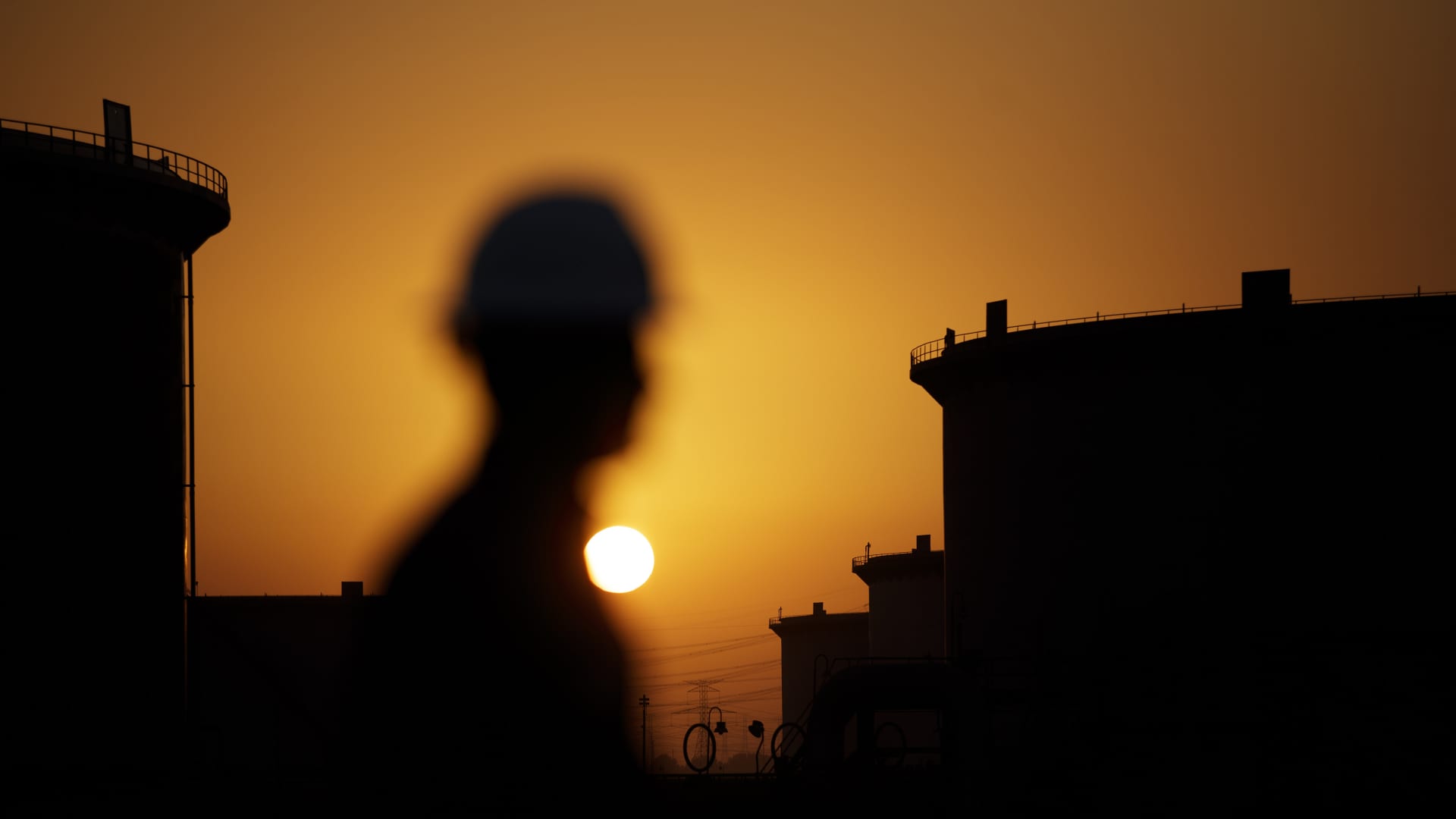
The sun sets beyond crude oil storage tanks at the Juaymah tank farm at Saudi Aramco’s Ras Tanura oil refinery and oil terminal in Ras Tanura, Saudi Arabia, on Monday, Oct. 1, 2018.
Bloomberg | Bloomberg | Getty Images
Global benchmark Brent crude falling below $70 a barrel in early September — its lowest in 33 months — is terrific news for consumers, who will consequently see lower prices at the pump.
It’s also the stuff of nightmares for OPEC+, for whom oil revenues are critical.
The oil producer alliance led by Saudi Arabia earlier this month decided to delay oil production hikes for two additional months in an effort to shore up prices, but so far to no avail. Low global demand forecasts, coupled with new oil supply coming from non-OPEC countries, spell a long period of subdued crude prices.
It’s led some in the market to ask the question: Have we officially reached “peak oil”? Has demand growth hit its apex, and is it just downhill from here?
By the forecasts of OPEC itself, that’s a hard no.
The oil producer group’s 2024 World Oil Outlook report, released Tuesday, predicts strong energy demand growth of 24% globally between now and 2050. It also forecasts “robust medium-term growth” in oil demand reaching 112.3 million barrels per day in 2029, an increase of 10.1 million barrels per day compared to 2023.
A fair number of energy analysts appear to disagree with that calculation — not least those at the International Energy Agency. The Paris-based agency sees demand actually leveling off by the end of the decade to around 106 million barrels per day, according to its annual mid-term outlook published in June. The IEA still sees global oil demand rising; it just forecasts a smaller rise, and expects it to peak by the end of the decade.

The battle of the forecasts between OPEC and the IEA has gained publicity in recent years, with the latter organization pushing hard for a net-zero future.
S&P Global Commodity Insights, meanwhile, sees the medium-term future as somewhere in between, with demand reaching a peak of 109 million barrels per day in 2034 and gradually declining to fall below 100 million barrels per day in 2050.
OPEC, by contrast, sees demand hitting a whopping 120 million barrels per day by 2050.
All parties agree that demand will fall in the developing world, while rising in emerging markets led by India.
The medium-term outlook
As for the near-to-medium term outlook, analysts are bearish on oil demand and prices. This is despite the early September announcement by OPEC+ that the group would be extending its crude production cuts into December in an attempt to limit market supply.
“That two month extra time hasn’t convinced anybody who’s skeptical about the market that that’s going to do much to shore up prices,” Dave Ernsberger, head of market reporting at S&P Global Commodity Insights, told CNBC.
“So that’s the in-the-moment issue. But the much bigger issue is, existentially speaking, are we moving past the moment of peak oil demand?”
Ernsberger pointed to the growth of alternative energy forms, including the increasing use of biofuels in the maritime industry.
“What we’re moving into is an era of post-demand growth. It’s not a post-oil moment, but it’s a post-growth moment. And how does OPEC+, how does the market readjust to a world of low or no growth in demand overall?”

Price increase prospects are also dimmed by China, the world’s largest oil importer, which has put itself on a dedicated path to electrification.
“The biggest threats to higher prices for OPEC+ are external,” Li-Chen Sim, a non-resident scholar at the Washington-based Middle East Institute, told CNBC.
Those are chiefly “lackluster demand, especially from China, oil supply from non-OPEC+ sources, and internal; some members are producing more than assigned quotas.”
Estimates by international and Chinese sources show a slowing demand for oil and refined products in China, Sim said.
That is in part due to slowing Chinese economic growth of around 3% to 5% annually in recent years — still better than many other countries, she noted.
“But there’s also a structural element to the reduction in oil consumption, driven by a conscious effort to reduce its high dependence on oil (and gas) imports, and expressed in policies such as electric vehicle uptake and encouraging expansion of renewable and nuclear power,” Sim added.
In the near term, OPEC+ is still expected to bring some production back in December, several countries in the alliance are producing beyond their quotas, and more supply is coming onto the market from non-OPEC+ producers like the U.S., Guyana, Brazil, and Canada.
“It’s difficult to see prices moving much higher from here as long as that threat is out there in the market to bring those supplies back,” Ernsberger said.
In the much longer term, the eventual decline of the oil era – if it happens – will be brought on due to changing demand rather than dwindling supply, many analysts argue.
It was the late Saudi Sheikh Ahmed Zaki Yamani who said in 2000: “The Stone Age came to an end not for a lack of stones and the Oil Age will end, but not for a lack of oil.”
Science & Environment
Take a look inside a $1.1 million ‘zero emissions’ home
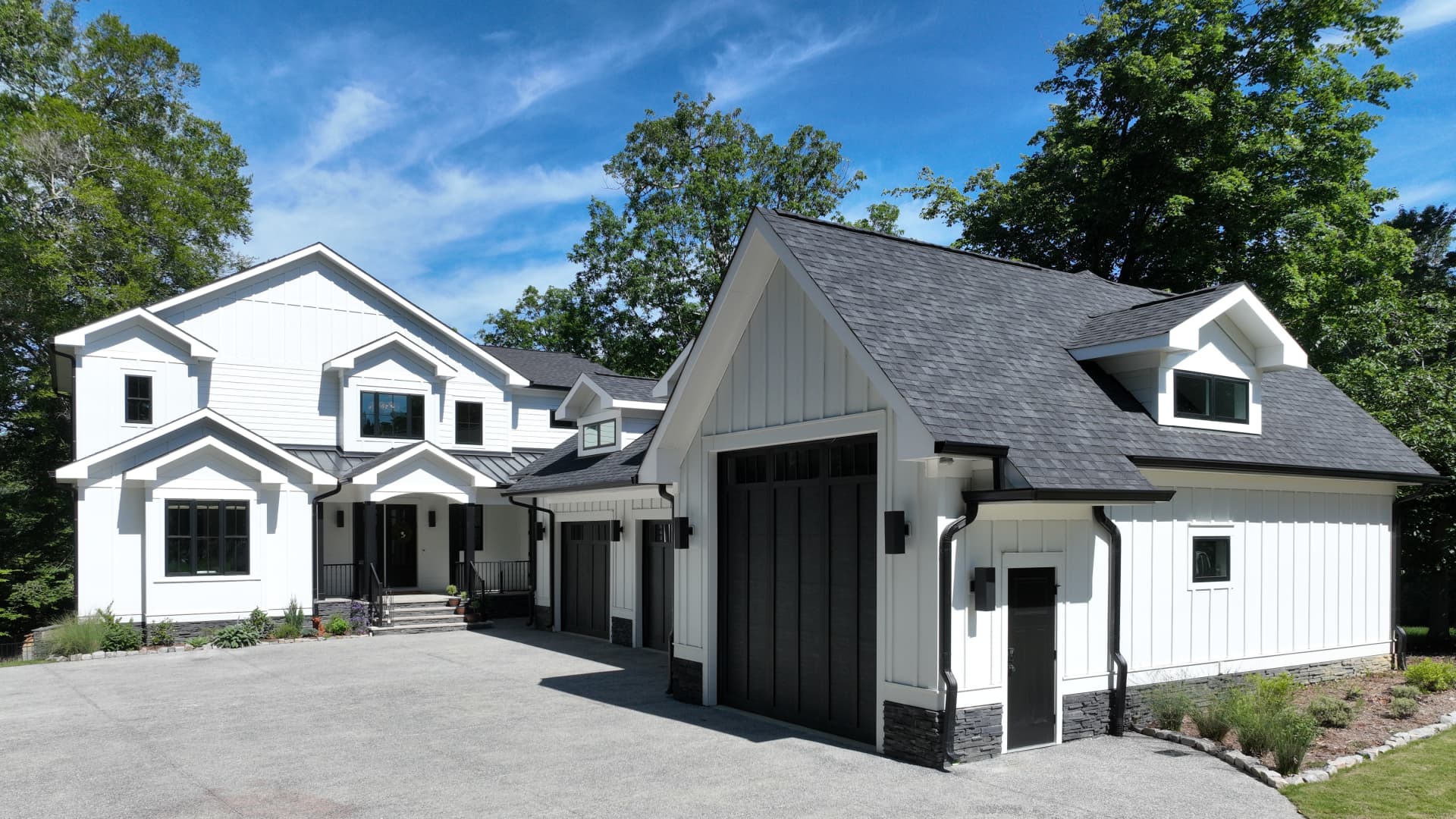
Courtesy: Wojciechowski Family
Real estate is a key puzzle piece in achieving the U.S.’ climate goals, according to federal officials.
Residential and commercial buildings account for 31% of the nation’s greenhouse gas emissions, after accounting for “indirect” emissions like electricity use, according to the Environmental Protection Agency. That’s more than other economic sectors like transportation and agriculture.
The Biden administration has adopted various policies to cut residential emissions.
The Inflation Reduction Act, enacted in 2022, offers financial benefits including tax breaks and rebates to homeowners who make their homes more energy-efficient, for example. The White House also recently issued guidelines for buildings in order to be considered “zero emissions,” meaning they are “energy efficient, free of onsite emissions from energy use and powered solely from clean energy,” according to the Department of Energy.
More from Personal Finance:
How EVs and gasoline cars compare on total cost
Here’s how to buy renewable energy from your electric utility
8 easy — and cheap — ways to cut your carbon emissions
Morgan Wojciechowski, 33, is among the first homeowners to get that federal “zero emissions” label. (That assessment was bestowed by the third-party firm Pearl Certification.)
Wojciechowski, her husband Casey, and their three dogs — Dixie, Bo and Charlie — moved into the newly built residence in Williamsburg, Virginia, in August 2023.
Wojciechowski, who is also the president of Healthy Communities, a local real-estate developer focused on sustainable construction, spoke with CNBC about her new home, its financial benefits and how consumers can best upgrade their homes to be more efficient.
The conversation has been edited and condensed for clarity.
Morgan Wojciechowski and her husband Casey.
Courtesy: Wojciechowski Family
Greg Iacurci: What does it mean for your home to be considered ‘zero emissions’?
Morgan Wojciechowski: It’s a very, very, very highly efficient home that’s all-electric. Those are kind of the first two bullet points of the White House definition.
The third part is we are part of the green energy program with [our power provider] Dominion. Not only am I producing solar [energy] and any excess is going back onto the grid, but the power from the grid coming into my home is clean and sustainable. It’s about $10 extra a month for me to get that clean energy.
GI: How much did your house cost to build?
MW: Like $1.1 million.
GI: And how big is the house?
MW: 5,800 square feet.
It’s a large home. But mine is not what everybody’s doing. My home was my personal project because I believe in sustainability and wanted to do it in a home that would be my forever home. But one that’s more replicable would be like what [Healthy Communities] builds at Walnut Farm, which is like 1,500 square feet. We’re selling it for $433,000.
GI: Can you break down your home’s estimated savings?
MW: Our utility bills are projected to be about $917 a year with [solar] panels, or around $80 a month.
The annual savings are $7,226 [relative to an average U.S. home, according to rater TopBuild Home Services]. That’s just from the efficiency of the home with solar.
If you took the solar production away, I would be saving $5,431 annually. The solar offsets it.
Courtesy: Wojciechowski Family
Courtesy: Wojciechowski Family
Courtesy: Wojciechowski Family
Courtesy: Wojciechowski Family
Courtesy: Wojciechowski Family
GI: What do you mean solar offsets it?
MW: You create energy. Your home uses that energy and sends excess energy back to Dominion. Those credits are stored in an account, and then those credits offset your bill. It’s called net metering.
GI: So the power company is paying you that money?
MW: Those credits are applied to your next billing cycle. They offset your overall utility bill, and that’s where your savings come in.
Solar panels only make sense if you build an energy-efficient home that’s really all-electric.
Courtesy: Wojciechowski Family
GI: Why is that?
MW: You have to have a home that’s constructed energy-efficiently enough or retrofitted — by replacing your windows with higher-grade windows, adding insulation — so that you will need fewer panels on your rooftop, so you have a quicker return on your investment. Solar only makes sense if you’re going to have a return on your investment within a few years.
GI: That makes solar more attractive?
MW: If you don’t do energy-efficient upgrades to a pre-existing home or if you don’t build a home that’s energy-efficient enough, you have to add more panels to compensate for the lack of energy efficiency. And if that number gets too big it turns people upside down.
Solar has to make sense with the home that you’re putting it on, or else, don’t do it. Maybe just upgrade your windows, add insulation, condition your crawl space, upgrade your mechanical systems.
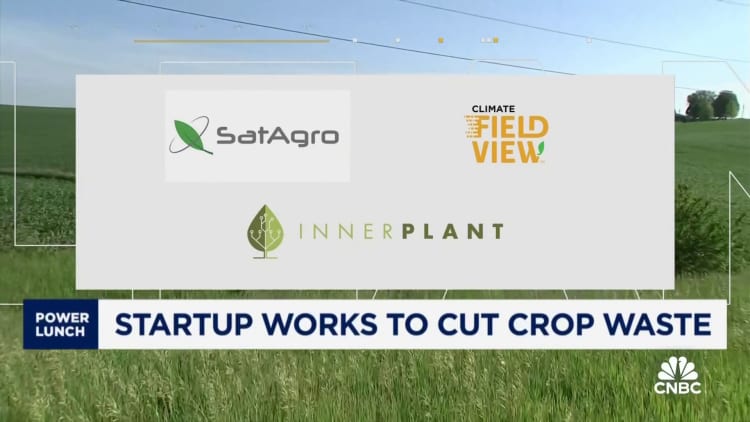
There are a lot of things consumers can do. You don’t have to do it all at one time. You don’t have to have a solar home to be zero emissions; you have to have an energy-efficient house that’s all-electric, and you have to buy renewable energy from your utility company.
That’s extremely approachable. Lots of people can do that. Everybody can join in at their level of sustainability.
GI: How do you recommend people get started?
MW: I would tell a consumer, why don’t you start with windows and doors. That’s a very easy one. Do that and see how you notice any [efficiency] changes.
In a lot of older homes windows are very old and they leak. Air is coming in and out. If you think about it, a house is like an envelope. You you want to seal the inside of your home the best that you can.
I would hit insulation next.
A lot of older homes have HVAC systems, duct work inside of their attic. Insulate it so that it’s a conditioned space, so that those building systems don’t have to work in overdrive to keep up with really hot temperatures or really cold temperatures. That keeps it more energy efficient.
And there are tax incentives [available] for energy-efficient upgrades to your home. Consumers can get and write them off, so that’s attractive to people as well.
GI: If you’re a renter, there are certain things that are out of your control. I suppose you can ask your landlord.
MW: Depending upon what your rental situation is. I feel like that’s a little bit more daunting, to change someone else’s mind. Once you get to your own home, eventually, then you have more say of what you can do.
Until then, you could be mindful about the energy you use. Turn lights off. I mean, that’s a real thing. People don’t turn lights off. I mean, even though I have a really efficient home, I have timers on things because I don’t want to be wasting energy. That’s an easy one that anybody could do.
-

 Womens Workouts2 days ago
Womens Workouts2 days ago3 Day Full Body Women’s Dumbbell Only Workout
-

 News7 days ago
News7 days agoYou’re a Hypocrite, And So Am I
-

 Technology1 week ago
Technology1 week agoWould-be reality TV contestants ‘not looking real’
-

 Sport6 days ago
Sport6 days agoJoshua vs Dubois: Chris Eubank Jr says ‘AJ’ could beat Tyson Fury and any other heavyweight in the world
-

 News3 days ago
News3 days agoOur millionaire neighbour blocks us from using public footpath & screams at us in street.. it’s like living in a WARZONE – WordupNews
-

 Science & Environment6 days ago
Science & Environment6 days ago‘Running of the bulls’ festival crowds move like charged particles
-

 Science & Environment6 days ago
Science & Environment6 days agoSunlight-trapping device can generate temperatures over 1000°C
-

 Science & Environment7 days ago
Science & Environment7 days agoHow to unsnarl a tangle of threads, according to physics
-

 Science & Environment7 days ago
Science & Environment7 days agoITER: Is the world’s biggest fusion experiment dead after new delay to 2035?
-

 Science & Environment6 days ago
Science & Environment6 days agoQuantum ‘supersolid’ matter stirred using magnets
-

 CryptoCurrency6 days ago
CryptoCurrency6 days agoEthereum is a 'contrarian bet' into 2025, says Bitwise exec
-

 Science & Environment7 days ago
Science & Environment7 days agoMaxwell’s demon charges quantum batteries inside of a quantum computer
-

 Science & Environment1 week ago
Science & Environment1 week agoTime travel sci-fi novel is a rip-roaringly good thought experiment
-

 Science & Environment7 days ago
Science & Environment7 days agoLiquid crystals could improve quantum communication devices
-

 Science & Environment7 days ago
Science & Environment7 days agoHow to wrap your mind around the real multiverse
-

 CryptoCurrency6 days ago
CryptoCurrency6 days agoDZ Bank partners with Boerse Stuttgart for crypto trading
-

 CryptoCurrency6 days ago
CryptoCurrency6 days agoBitcoin bulls target $64K BTC price hurdle as US stocks eye new record
-

 Science & Environment7 days ago
Science & Environment7 days agoWhy this is a golden age for life to thrive across the universe
-

 Science & Environment6 days ago
Science & Environment6 days agoHyperelastic gel is one of the stretchiest materials known to science
-

 Science & Environment6 days ago
Science & Environment6 days agoQuantum forces used to automatically assemble tiny device
-

 Science & Environment7 days ago
Science & Environment7 days agoLaser helps turn an electron into a coil of mass and charge
-

 Science & Environment1 week ago
Science & Environment1 week agoNerve fibres in the brain could generate quantum entanglement
-

 Science & Environment1 week ago
Science & Environment1 week agoCaroline Ellison aims to duck prison sentence for role in FTX collapse
-

 Science & Environment6 days ago
Science & Environment6 days agoNuclear fusion experiment overcomes two key operating hurdles
-

 CryptoCurrency6 days ago
CryptoCurrency6 days agoBitcoin miners steamrolled after electricity thefts, exchange ‘closure’ scam: Asia Express
-

 CryptoCurrency6 days ago
CryptoCurrency6 days agoCardano founder to meet Argentina president Javier Milei
-

 CryptoCurrency6 days ago
CryptoCurrency6 days agoDorsey’s ‘marketplace of algorithms’ could fix social media… so why hasn’t it?
-

 CryptoCurrency6 days ago
CryptoCurrency6 days agoLow users, sex predators kill Korean metaverses, 3AC sues Terra: Asia Express
-

 Science & Environment3 days ago
Science & Environment3 days agoMeet the world's first female male model | 7.30
-

 News6 days ago
News6 days agoIsrael strikes Lebanese targets as Hizbollah chief warns of ‘red lines’ crossed
-

 Technology6 days ago
Technology6 days agoiPhone 15 Pro Max Camera Review: Depth and Reach
-

 News6 days ago
News6 days agoBrian Tyree Henry on voicing young Megatron, his love for villain roles
-

 Health & fitness1 week ago
Health & fitness1 week agoThe secret to a six pack – and how to keep your washboard abs in 2022
-

 CryptoCurrency6 days ago
CryptoCurrency6 days agoRedStone integrates first oracle price feeds on TON blockchain
-

 CryptoCurrency6 days ago
CryptoCurrency6 days agoSEC asks court for four months to produce documents for Coinbase
-

 CryptoCurrency6 days ago
CryptoCurrency6 days ago‘No matter how bad it gets, there’s a lot going on with NFTs’: 24 Hours of Art, NFT Creator
-

 CryptoCurrency6 days ago
CryptoCurrency6 days agoBlockdaemon mulls 2026 IPO: Report
-

 CryptoCurrency6 days ago
CryptoCurrency6 days agoCoinbase’s cbBTC surges to third-largest wrapped BTC token in just one week
-

 Sport6 days ago
Sport6 days agoUFC Edmonton fight card revealed, including Brandon Moreno vs. Amir Albazi headliner
-

 Science & Environment6 days ago
Science & Environment6 days agoHow one theory ties together everything we know about the universe
-

 Science & Environment6 days ago
Science & Environment6 days agoQuantum time travel: The experiment to ‘send a particle into the past’
-

 Science & Environment6 days ago
Science & Environment6 days agoPhysicists are grappling with their own reproducibility crisis
-

 CryptoCurrency6 days ago
CryptoCurrency6 days ago2 auditors miss $27M Penpie flaw, Pythia’s ‘claim rewards’ bug: Crypto-Sec
-

 CryptoCurrency6 days ago
CryptoCurrency6 days agoJourneys: Robby Yung on Animoca’s Web3 investments, TON and the Mocaverse
-

 CryptoCurrency6 days ago
CryptoCurrency6 days ago$12.1M fraud suspect with ‘new face’ arrested, crypto scam boiler rooms busted: Asia Express
-

 CryptoCurrency6 days ago
CryptoCurrency6 days agoCertiK Ventures discloses $45M investment plan to boost Web3
-

 CryptoCurrency6 days ago
CryptoCurrency6 days agoVitalik tells Ethereum L2s ‘Stage 1 or GTFO’ — Who makes the cut?
-
Business6 days ago
How Labour donor’s largesse tarnished government’s squeaky clean image
-

 News6 days ago
News6 days agoBrian Tyree Henry on voicing young Megatron, his love for villain roles
-

 Womens Workouts4 days ago
Womens Workouts4 days agoBest Exercises if You Want to Build a Great Physique
-

 Womens Workouts4 days ago
Womens Workouts4 days agoEverything a Beginner Needs to Know About Squatting
-

 News6 days ago
News6 days agoChurch same-sex split affecting bishop appointments
-

 Politics1 week ago
Politics1 week agoTrump says he will meet with Indian Prime Minister Narendra Modi next week
-

 Politics6 days ago
Politics6 days agoLabour MP urges UK government to nationalise Grangemouth refinery
-

 News7 days ago
News7 days agoRoad rage suspects in custody after gunshots, drivers ramming vehicles near Boise
-

 Health & fitness1 week ago
Health & fitness1 week agoThe maps that could hold the secret to curing cancer
-

 CryptoCurrency6 days ago
CryptoCurrency6 days agoHelp! My parents are addicted to Pi Network crypto tapper
-

 CryptoCurrency6 days ago
CryptoCurrency6 days agoCrypto scammers orchestrate massive hack on X but barely made $8K
-

 Science & Environment6 days ago
Science & Environment6 days agoUK spurns European invitation to join ITER nuclear fusion project
-

 Science & Environment6 days ago
Science & Environment6 days agoWhy we need to invoke philosophy to judge bizarre concepts in science
-

 Science & Environment6 days ago
Science & Environment6 days agoFuture of fusion: How the UK’s JET reactor paved the way for ITER
-

 Science & Environment6 days ago
Science & Environment6 days agoHow do you recycle a nuclear fusion reactor? We’re about to find out
-

 CryptoCurrency6 days ago
CryptoCurrency6 days agoSEC sues ‘fake’ crypto exchanges in first action on pig butchering scams
-

 CryptoCurrency6 days ago
CryptoCurrency6 days agoCZ and Binance face new lawsuit, RFK Jr suspends campaign, and more: Hodler’s Digest Aug. 18 – 24
-

 CryptoCurrency6 days ago
CryptoCurrency6 days agoTelegram bot Banana Gun’s users drained of over $1.9M
-

 CryptoCurrency6 days ago
CryptoCurrency6 days agoVonMises bought 60 CryptoPunks in a month before the price spiked: NFT Collector
-

 CryptoCurrency6 days ago
CryptoCurrency6 days ago‘Silly’ to shade Ethereum, the ‘Microsoft of blockchains’ — Bitwise exec
-

 CryptoCurrency6 days ago
CryptoCurrency6 days agoEthereum falls to new 42-month low vs. Bitcoin — Bottom or more pain ahead?
-
Business6 days ago
Thames Water seeks extension on debt terms to avoid renationalisation
-
Politics6 days ago
‘Appalling’ rows over Sue Gray must stop, senior ministers say | Sue Gray
-

 News4 days ago
News4 days agoBangladesh Holds the World Accountable to Secure Climate Justice
-

 News3 days ago
News3 days agoFour dead & 18 injured in horror mass shooting with victims ‘caught in crossfire’ as cops hunt multiple gunmen
-

 Technology6 days ago
Technology6 days agoFivetran targets data security by adding Hybrid Deployment
-

 Science & Environment6 days ago
Science & Environment6 days agoSingle atoms captured morphing into quantum waves in startling image
-

 Money7 days ago
Money7 days agoWhat estate agents get up to in your home – and how they’re being caught
-

 Technology1 week ago
Technology1 week agoCan technology fix the ‘broken’ concert ticketing system?
-

 Science & Environment6 days ago
Science & Environment6 days agoA new kind of experiment at the Large Hadron Collider could unravel quantum reality
-

 Fashion Models6 days ago
Fashion Models6 days agoMixte
-

 Science & Environment6 days ago
Science & Environment6 days agoHow Peter Higgs revealed the forces that hold the universe together
-

 News7 days ago
News7 days ago▶️ Media Bias: How They Spin Attack on Hezbollah and Ignore the Reality
-

 Science & Environment6 days ago
Science & Environment6 days agoBeing in two places at once could make a quantum battery charge faster
-

 CryptoCurrency6 days ago
CryptoCurrency6 days agoLouisiana takes first crypto payment over Bitcoin Lightning
-

 Science & Environment6 days ago
Science & Environment6 days agoTiny magnet could help measure gravity on the quantum scale
-

 Science & Environment6 days ago
Science & Environment6 days agoA tale of two mysteries: ghostly neutrinos and the proton decay puzzle
-

 CryptoCurrency6 days ago
CryptoCurrency6 days agoDecentraland X account hacked, phishing scam targets MANA airdrop
-

 CryptoCurrency6 days ago
CryptoCurrency6 days agoElon Musk is worth 100K followers: Yat Siu, X Hall of Flame
-

 CryptoCurrency6 days ago
CryptoCurrency6 days agoBitcoin price hits $62.6K as Fed 'crisis' move sparks US stocks warning
-

 CryptoCurrency6 days ago
CryptoCurrency6 days agoBeat crypto airdrop bots, Illuvium’s new features coming, PGA Tour Rise: Web3 Gamer
-

 CryptoCurrency6 days ago
CryptoCurrency6 days agoMemecoins not the ‘right move’ for celebs, but DApps might be — Skale Labs CMO
-

 CryptoCurrency6 days ago
CryptoCurrency6 days agoETH falls 6% amid Trump assassination attempt, looming rate cuts, ‘FUD’ wave
-
Politics6 days ago
The Guardian view on 10 Downing Street: Labour risks losing the plot | Editorial
-

 Politics6 days ago
Politics6 days agoI’m in control, says Keir Starmer after Sue Gray pay leaks
-
Business6 days ago
UK hospitals with potentially dangerous concrete to be redeveloped
-
Politics6 days ago
‘Hundreds’ of prisoners freed early in England and Wales not fitted with tags | Prisons and probation
-
Business6 days ago
Axel Springer top team close to making eight times their money in KKR deal
-

 Politics6 days ago
Politics6 days agoParties, brothels and drugs plague holiday let neighbours, say MPs
-

 News6 days ago
News6 days ago“Beast Games” contestants sue MrBeast’s production company over “chronic mistreatment”
-

 News6 days ago
News6 days agoSean “Diddy” Combs denied bail again in federal sex trafficking case
-

 News6 days ago
News6 days agoSean “Diddy” Combs denied bail again in federal sex trafficking case in New York
-

 News6 days ago
News6 days agoBrian Tyree Henry on his love for playing villains ahead of “Transformers One” release


You must be logged in to post a comment Login